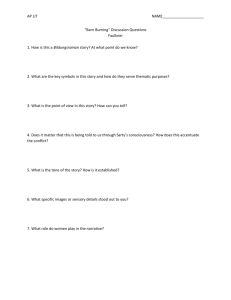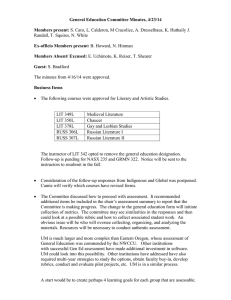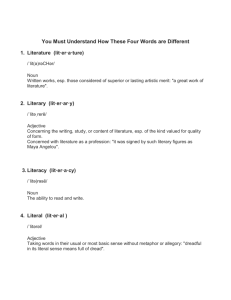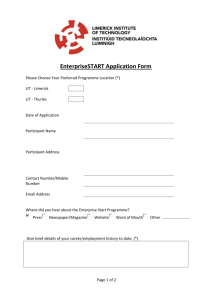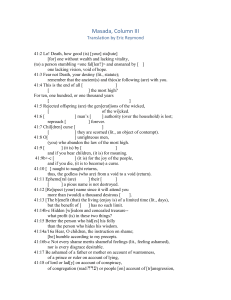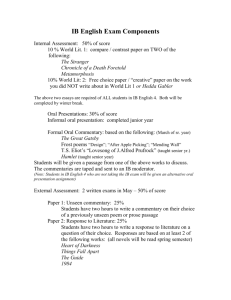w ie ev R
advertisement
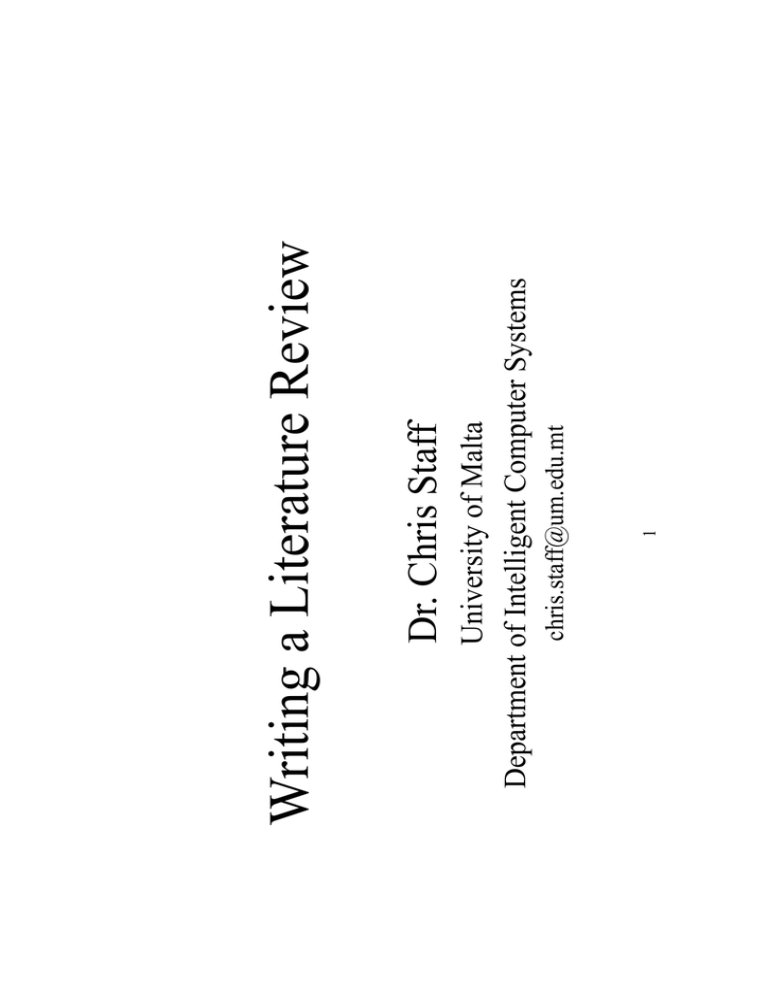
1 chris.staff@um.edu.mt University of Malta Department of Intelligent Computer Systems Dr. Chris Staff Writing a Literature Review 2 – How to read efficiently:-) – How to use the literature to find literature – How to take notes and combine them into a review • Writing a Literature Review – The purpose of a report – Chapter/Section Overview • Report Writing (for ICT) Overview 3 – To communicate your work to an audience – To demonstrate your understanding of a domain and how your work fits into/contributes to/extends (as appropriate) a domain – To back up your claims through appropriate evaluation – To discuss the significance of the results of your evaluation • The purpose of a report Report Writing 4 – Report should be free from spelling mistakes and grammatical errors – Ideas should be communicated clearly (simple sentences, etc.) and in an appropriate style – There should be a logical structure to the way you present your argument – Each chapter/section should introduce what’s coming up and conclude with the significant points you want to make – There should be no secrets! Early disclosure is expected. • Implications Report Writing 5 – You are expected to read relevant work of others… – … and report on it (be critical!) – Clearly distinguish between your own work and the work of others – Reference properly and consistently • Implications Report Writing 6 – You must back up your claims (either by citing the work of others, or by referring to the results of your own evaluation) – Results should be presented in a manner appropriate for the domain (e.g., how is relevant work evaluated?) • Implications Report Writing 7 • Easiest to do if you have access to shared test/evaluation data or can replicate experiments done by others and compare performance metrics (measurements) – Ideally, compare your results to results of other similar work • both in terms of how it fits into the literature and in terms of the results you obtain – You must demonstrate that you understand how your work fits into the domain • Implications Report Writing – – – – – – – – 8 Abstract Tables of contents (figures, tables, etc.) Introduction Background/Literature Review Design/Implementation Evaluation & Testing Discussion of Results Conclusions and Future Work • Typical structure of a report Report Writing 9 – To describe concisely the problem you tackled, the method you employed, the results you obtained, and a critical statement about the outcome • Abstract Report Writing –… 10 • Table of Contents (figures, tables, etc.) Report Writing – – – – – – – – 11 What is the problem you’re trying to solve? What is your research question? NB: CIS students Why is it an important problem? Main Goal and Objectives What’s your motivation for solving it? should be a separate What are your objectives? chapter (c. one page) What are your main/secondary contributions? What were your main/overall results? Chapter/Section overview • Introduction Report Writing 12 – What prior work is relevant to yours? – And why? • However, if work incorporates more than one domain, you are likely to have to give a brief background to each domain – Normally, assume that reader is someone with your experience/knowledge *before* you did the current work • Background/Literature Review Report Writing 13 • You’re going to demonstrate that your approach builds on the work of others, though you shouldn’t refer to your current work here • You should be critical of the work of others • You’re also trying to show that you haven’t missed anything significant/important – In your report you are trying to convince reader that your approach is sensible • Background/Literature Review Report Writing 14 • What are the different approaches to each processing step, and which systems use each approach? With what costs? success? – I like to structure my Lit Review on a ‘model’ (system) architecture to solve the problem I’m working on – What significant “processing steps” are needed to solve the problem? • Background/Literature Review Report Writing 15 • Shows that you’ve thought about the problem; been exposed to different approaches to embrace those that work, avoid those that don’t; acquired a certain depth of knowledge; are able to share that knowledge critically • Stick to peer-reviewed articles/books. Avoid wikipedia, magazines, newspapers! – Lit Review should be a cross-section of the literature, rather than a sequential description of systems – Keep description of other systems high-level – Don’t underestimate the importance of the Lit Review • Background/Literature Review Report Writing 16 • It can follow the ideal ‘model’ you presented in the Lit. Review • You can, and indeed should, cross-reference to the Lit. Review • Systems on which you’ve based your approach can be described in more detail here – Now you can talk about your approach, and reasons for it • Design/Implementation Report Writing 17 – Remember to justify every decision that you make! – Remember to adequately reference technologies you use – Don’t go overboard with system schematics (most of these can go into an appendix), unless it is appropriate to do so – Write and describe, don’t just draw! • Design/Implementation Report Writing 18 --CIS/CSAI:Especially in implementation chapter, talk about major data structures and operations on them, rather than organise it by function! How do major data structures interface? CCE/NME: design issues, compromises, technologies. implementation cost – What technologies did you use and why? • If you’ve used code developed by someone else, reference it! – Do give screen shots (remember to no. figures, tables, etc., and to refer to them in the text) • Design/Implementation Report Writing 19 – What claims are you making, and how are you going to ‘prove’ them? – How are these types of system normally evaluated? (Give a small lit review, if there are several acceptable approaches, and remember to provide references) – Are you able to follow normal evaluation, or do you have to do things differently (because of cost/time/etc)? • Evaluation Report Writing 20 – Describe your experiments/simulation and or experimental details, and the results you obtained (be objective! Don’t discuss the implications yet) – Use tables, graphs, charts, etc. to describe results, but don’t present the same results in different ways • Equipment, participants (how many? What skills? How did you get them to participate? etc.), duration, location, etc. – Describe your evaluation set-up or simulation environment • Evaluation Report Writing 21 • This should include a test plan and the test results – Describe the results, as well as presenting them – Draw attention to anomalous results – If required and/or appropriate, you should also have a section on testing – discuss with your supervisor • Evaluation Report Writing 22 • "Ideas do not have to be correct in order to be good; it's only necessary that, if they do fail, they do so in an interesting way" - Robert Rosen – If you don’t get the results you expected/hoped for, don’t be afraid to explain why this may have happened • Including any anomalous results – Explain why you obtained the results you obtained • Both independently and in comparison to similar systems – Objectively explain the significance of your results • Discussion of Results Report Writing 23 – More than just a summary! – Draw conclusions from your work (was it a worthwhile approach? What would you do differently? Etc.) – In Introduction, you asked your ‘research question’ and you stated your objectives. Answer the question and state whether you met your objectives – Future work… • Conclusion Report Writing 24 • How to read efficiently :-) • How to use the literature to find literature • How to take notes and combine them into a review Writing a Literature Review 25 – Read abstract – If paper is relevant, read introduction and conclusion – If still relevant, read literature review and approach/ overview – If relevant, read evaluation and results – Only if absolutely necessary, read detailed design/implementation • How to Read Efficiently Writing a Literature Review 26 • If you know the problem you’re trying to solve, your reading can be focussed • If you’re looking for a problem to solve, your reading strategy must change (initially) – Chicken and Egg • How to Read Efficiently Writing a Literature Review 27 • The paper you’re reading • Significant papers that the paper you’re reading refers to! – If a paper is relevant, it should have a relevant literature review – Read it, and track down and read the papers it refers to – Use system like CiteSeer to find other papers that refer to: • How to use the literature to find literature Writing a Literature Review 28 – If the paper is relevant, write down its bibliographic reference (entry should be complete) and give it an id – Jot down notes of anything (statements/opinions) that is relevant/interesting (in the sections you’re reading) – Remember to put direct quotations (sentences/ phrases/unusual terminology) into quotes! • How to take notes Writing a Literature Review 29 • You can now make statements about groups of papers – You should end up with a series of statements related to each processing step about each paper you read – Remember to use the ref id with each statement! • Based on your research, build a model of the (reasonably high-level) processing steps needed • Organise your notes around the model Writing a Literature Review 30 • Short for a (2-page) poster; longer for a (10-page) conference or journal paper; longer still for a research publication (e.g., report, dissertation, thesis), 10% of report length • So choose most important/significant claims for shorter pieces – Length will vary according to publication • Write up your literature review! Writing a Literature Review 31 • Example… Document Fusion Literature Review… Writing a Literature Review 32 • ‘Plagiarism… and How to Avoid it’ • JISC Plagiarism Advisory Service, “A Quick Guide to Referencing” – For more information see: • At the point in your report at which you make the claim • And full referencing details of the source in the references list – Every time you make a claim, you need to provide a reference • Referencing your sources Writing a Literature Review 33 • Comrie, A. C., Scientific Report Writing. • UW-Madison Writing Center, 2006, Scientific Reports • Report Tips • Dolphin, W. D., Writing Lab Reports and Scientific Papers More Links
